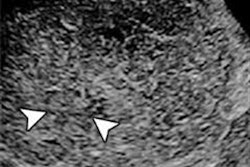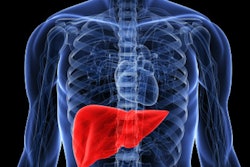LOS ANGELES - Contrast-enhanced ultrasound offers a cost-effective, radiation-free alternative to CT for characterizing focal liver lesions, according to research presented April 18 at the American Roentgen Ray Society (ARRS) meeting.
The findings are timely, considering that the U.S. Food and Drug Administration (FDA) approved for the first time on April 4 the use of an ultrasound contrast agent for radiology applications. The agency granted approval to Bracco Diagnostics for the use of its Lumason contrast agent for focal liver lesions.
Being able to use ultrasound for focal liver lesions is good news for patients who might need to avoid CT or MR due to complicating factors such as compromised renal function or an allergy to contrast media -- or for young or pregnant patients for whom avoiding radiation is desirable, said presenter Dr. G. Rani Karur of Kasturba Medical College in Manipal, India.
"Not only is contrast-enhanced ultrasound less expensive than cross-sectional imaging, it is safer for some patients," Karur said.
Watching for washout
Karur and colleagues compared the sensitivity, specificity, and diagnostic accuracy of contrast-enhanced ultrasound with that of unenhanced ultrasound to characterize focal liver lesions. They also compared the enhancement characteristics of these lesions in various phases of contrast-enhanced ultrasound with contrast CT, and investigated the time to washout for malignant liver lesions.
The team included 80 patients with indeterminate liver lesions detected on routine ultrasound who were referred for contrast-enhanced CT and contrast-enhanced ultrasound between November 2011 and August 2013. The ultrasound scans were performed on a Philips Healthcare iU22 ultrasound system with a 1- to 5-MHz linear transducer.
Patients underwent contrast-enhanced ultrasound with a 1.2- to 2.5-mL dose of Bracco's Lumason ultrasound contrast agent (previously known as SonoVue in the U.S.), followed by a saline flush of 5 mL. The lesions were observed in three phases from time of injection for up to five minutes: arterial (25 to 35 seconds), extended portal venous (35 to 90 seconds), and delayed (90 seconds through the remaining observation time).
The researchers tracked several parameters:
- The presence or absence of contrast enhancement
- The type of enhancement, whether homogeneous or heterogeneous
- The lesion's vascular quality, whether hypervascular, hypovascular, or isovascular
- Whether contrast enhancement was peripheral, central, or diffuse
- The time and pattern of contrast washout
Adding contrast helped, Karur and colleagues found: Ultrasound with contrast had higher sensitivity, specificity, and diagnostic accuracy in characterizing liver lesions as benign or malignant, compared with unenhanced ultrasound.
| Contrast vs. noncontrast ultrasound for liver lesions | ||
| Noncontrast-enhanced US | Contrast-enhanced US | |
| Sensitivity | 95.7% | 98.5% |
| Specificity | 77.7% | 100% |
| Diagnostic accuracy | 93.8% | 98.8% |
In addition, contrast-enhanced ultrasound performed just as well as CT with contrast, according to Karur's group. Using Kappa to measure agreement, the group found nearly perfect concordance between contrast-enhanced ultrasound and contrast-enhanced CT for all features related to enhancement and washout of liver lesions in each phase.
Karur conceded that the study had limitations, including the operator-dependent nature of ultrasound contrast and the fact that imaging deeper lesions is technically difficult, she said. But its benefits remain.
"Since ultrasound is a much less expensive exam than CT, it offers an economical alternative for characterizing focal liver lesions," Karur concluded. "And it's good for patients for whom additional radiation is not a good idea."




















